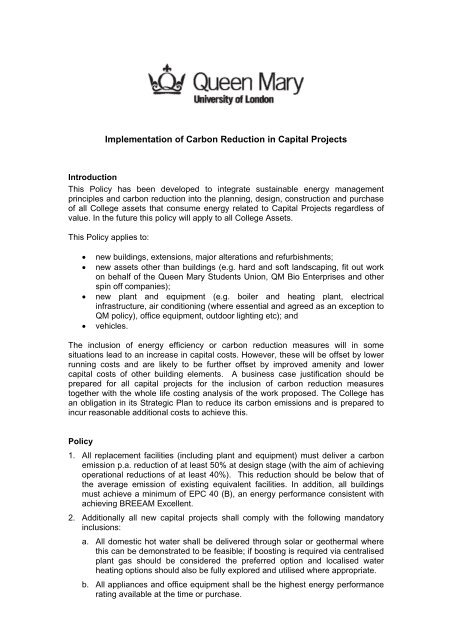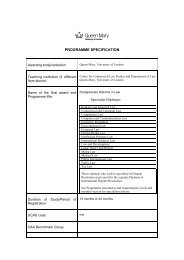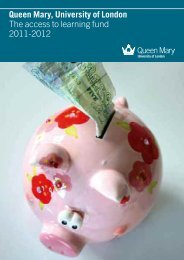Policy for the Implementation of Carbon Reduction in Capital Projects
Policy for the Implementation of Carbon Reduction in Capital Projects
Policy for the Implementation of Carbon Reduction in Capital Projects
Create successful ePaper yourself
Turn your PDF publications into a flip-book with our unique Google optimized e-Paper software.
<strong>Implementation</strong> <strong>of</strong> <strong>Carbon</strong> <strong>Reduction</strong> <strong>in</strong> <strong>Capital</strong> <strong>Projects</strong>IntroductionThis <strong>Policy</strong> has been developed to <strong>in</strong>tegrate susta<strong>in</strong>able energy managementpr<strong>in</strong>ciples and carbon reduction <strong>in</strong>to <strong>the</strong> plann<strong>in</strong>g, design, construction and purchase<strong>of</strong> all College assets that consume energy related to <strong>Capital</strong> <strong>Projects</strong> regardless <strong>of</strong>value. In <strong>the</strong> future this policy will apply to all College Assets.This <strong>Policy</strong> applies to:new build<strong>in</strong>gs, extensions, major alterations and refurbishments;new assets o<strong>the</strong>r than build<strong>in</strong>gs (e.g. hard and s<strong>of</strong>t landscap<strong>in</strong>g, fit out workon behalf <strong>of</strong> <strong>the</strong> Queen Mary Students Union, QM Bio Enterprises and o<strong>the</strong>rsp<strong>in</strong> <strong>of</strong>f companies);new plant and equipment (e.g. boiler and heat<strong>in</strong>g plant, electrical<strong>in</strong>frastructure, air condition<strong>in</strong>g (where essential and agreed as an exception toQM policy), <strong>of</strong>fice equipment, outdoor light<strong>in</strong>g etc); andvehicles.The <strong>in</strong>clusion <strong>of</strong> energy efficiency or carbon reduction measures will <strong>in</strong> somesituations lead to an <strong>in</strong>crease <strong>in</strong> capital costs. However, <strong>the</strong>se will be <strong>of</strong>fset by lowerrunn<strong>in</strong>g costs and are likely to be fur<strong>the</strong>r <strong>of</strong>fset by improved amenity and lowercapital costs <strong>of</strong> o<strong>the</strong>r build<strong>in</strong>g elements. A bus<strong>in</strong>ess case justification should beprepared <strong>for</strong> all capital projects <strong>for</strong> <strong>the</strong> <strong>in</strong>clusion <strong>of</strong> carbon reduction measurestoge<strong>the</strong>r with <strong>the</strong> whole life cost<strong>in</strong>g analysis <strong>of</strong> <strong>the</strong> work proposed. The College hasan obligation <strong>in</strong> its Strategic Plan to reduce its carbon emissions and is prepared to<strong>in</strong>cur reasonable additional costs to achieve this.<strong>Policy</strong>1. All replacement facilities (<strong>in</strong>clud<strong>in</strong>g plant and equipment) must deliver a carbonemission p.a. reduction <strong>of</strong> at least 50% at design stage (with <strong>the</strong> aim <strong>of</strong> achiev<strong>in</strong>goperational reductions <strong>of</strong> at least 40%). This reduction should be below that <strong>of</strong><strong>the</strong> average emission <strong>of</strong> exist<strong>in</strong>g equivalent facilities. In addition, all build<strong>in</strong>gsmust achieve a m<strong>in</strong>imum <strong>of</strong> EPC 40 (B), an energy per<strong>for</strong>mance consistent withachiev<strong>in</strong>g BREEAM Excellent.2. Additionally all new capital projects shall comply with <strong>the</strong> follow<strong>in</strong>g mandatory<strong>in</strong>clusions:a. All domestic hot water shall be delivered through solar or geo<strong>the</strong>rmal wherethis can be demonstrated to be feasible; if boost<strong>in</strong>g is required via centralisedplant gas should be considered <strong>the</strong> preferred option and localised waterheat<strong>in</strong>g options should also be fully explored and utilised where appropriate.b. All appliances and <strong>of</strong>fice equipment shall be <strong>the</strong> highest energy per<strong>for</strong>mancerat<strong>in</strong>g available at <strong>the</strong> time or purchase.
c. All o<strong>the</strong>r miscellaneous purchases <strong>for</strong> items that that use energy shall complywith HEFCE’s Purchas<strong>in</strong>g <strong>for</strong> Susta<strong>in</strong>ability: Guidance <strong>for</strong> Higher EducationInstitutions.3. <strong>Carbon</strong> reductions need to be “real” reductions <strong>in</strong> order to meet <strong>the</strong> College'scommitment to reduce carbon emissions through <strong>the</strong> <strong>Carbon</strong> Management and<strong>Implementation</strong> Plan, and should not be achieved through <strong>the</strong> purchase <strong>of</strong>renewable energy products from energy retailers or through <strong>of</strong>fsett<strong>in</strong>g.ObjectivesThe objectives <strong>of</strong> this <strong>Policy</strong> are to: Contribute to achiev<strong>in</strong>g <strong>the</strong> College target to reduce Scope 1 and 2 carbonemissions (direct fuel and electricity consumption) by 34% from a 2005/6basel<strong>in</strong>e by 2020. This essentially means capp<strong>in</strong>g its total greenhouse gasemissions at 16,000 t/CO 2 p.a. (see <strong>the</strong> College <strong>Carbon</strong> Management and<strong>Implementation</strong> plan <strong>for</strong> more <strong>in</strong><strong>for</strong>mation). Guide College staff and consultants deliver<strong>in</strong>g projects on <strong>the</strong> <strong>in</strong>corporation <strong>of</strong>susta<strong>in</strong>able energy management pr<strong>in</strong>ciples <strong>in</strong>to <strong>the</strong> design <strong>of</strong> build<strong>in</strong>g andplant assets, construction and procurement. Create assets that m<strong>in</strong>imise energy consumption and promote renewableenergy alternatives. Fur<strong>the</strong>r develop <strong>the</strong> system <strong>for</strong> management <strong>of</strong> energy across <strong>the</strong> College. Ensure that suppliers and contractors are also work<strong>in</strong>g <strong>in</strong> a susta<strong>in</strong>ablemanner e.g. reduc<strong>in</strong>g <strong>the</strong> total mileage travelled by vehicles and suppliesused <strong>in</strong> College projects.Guidel<strong>in</strong>es:The follow<strong>in</strong>g is a list <strong>of</strong> susta<strong>in</strong>able energy management pr<strong>in</strong>ciples that are to beconsidered <strong>in</strong> <strong>the</strong> development <strong>of</strong> all assets.Build<strong>in</strong>gsAll build<strong>in</strong>gs:<strong>in</strong>corporate passive solar design to maximise daylight<strong>in</strong>g and passive heat<strong>in</strong>gand cool<strong>in</strong>g opportunities; <strong>in</strong>corporate energy efficient design to m<strong>in</strong>imise light<strong>in</strong>g, active heat<strong>in</strong>g andcool<strong>in</strong>g requirements; optimise opportunities to use renewable energy sources and <strong>in</strong>corporaterenewable energy technologies wherever possible; provide efficient control and effective ma<strong>in</strong>tenance systems that <strong>in</strong>corporatemonitor<strong>in</strong>g <strong>of</strong> energy consumption; m<strong>in</strong>imise embodied energy <strong>in</strong> construction materials; <strong>the</strong>re is a presumption aga<strong>in</strong>st provid<strong>in</strong>g cool<strong>in</strong>g plant and heat<strong>in</strong>g andcool<strong>in</strong>g is to be with<strong>in</strong> <strong>the</strong> limits prescribed by <strong>the</strong> College.Plant and equipment: Specify energy efficient equipment and light<strong>in</strong>g systems.Vehicles: Ensure <strong>the</strong> m<strong>in</strong>imum use <strong>of</strong> each vehicle.Page 2 <strong>of</strong> 3
Where <strong>the</strong>re are alternative vehicles <strong>of</strong> equivalent usefulness, select <strong>the</strong> onewith <strong>the</strong> lowest fuel use.RequirementsThe follow<strong>in</strong>g requirements <strong>of</strong> <strong>the</strong> <strong>Policy</strong> apply to all capital works projects regardless<strong>of</strong> value, location or use:1. All replacement facilities (<strong>in</strong>clud<strong>in</strong>g plant and equipment) must have anannual greenhouse gas emission reduction <strong>of</strong> at least 50% at design stage(with <strong>the</strong> aim <strong>of</strong> achiev<strong>in</strong>g operational reductions <strong>of</strong> at least 40%). Thisreduction should be below that <strong>of</strong> <strong>the</strong> average emission <strong>of</strong> exist<strong>in</strong>g equivalentfacilities. In addition, all build<strong>in</strong>gs must achieve a m<strong>in</strong>imum <strong>of</strong> EPC 40 (B), anenergy per<strong>for</strong>mance consistent with achiev<strong>in</strong>g BREEAM Excellent.2. Designers may use any methods to achieve <strong>the</strong> target <strong>in</strong>clud<strong>in</strong>g energyefficiency, fuel substitution and/or renewable energy systems.3. The threshold cost-benefit <strong>for</strong> projects is a net life-cycle cost benefit <strong>of</strong>£50/tCO 2. <strong>Projects</strong> which do not meet this f<strong>in</strong>ancial criterion will be consideredby <strong>the</strong> Director <strong>of</strong> Estates on a case by case basis.4. All implementation plans and subsequent project plans must show predictedsav<strong>in</strong>gs <strong>of</strong> at least 125% <strong>of</strong> <strong>the</strong> required carbon reduction to m<strong>in</strong>imise <strong>the</strong> risk<strong>of</strong> sav<strong>in</strong>gs not be<strong>in</strong>g achieved.5. All new major build<strong>in</strong>gs must have an <strong>in</strong>dependent review <strong>of</strong> carbon reduction<strong>in</strong>clusions, <strong>in</strong>clud<strong>in</strong>g f<strong>in</strong>ancial assessments, with<strong>in</strong> <strong>the</strong> Feasibility Assessment.These reviews must be carried out by a suitably qualified energy consultantand be provided to <strong>the</strong> Head <strong>of</strong> Energy and Environment <strong>for</strong> comment.6. Any modification <strong>of</strong> plant and/or equipment us<strong>in</strong>g more than 20% <strong>of</strong> <strong>the</strong>energy consumption <strong>in</strong> a major build<strong>in</strong>g must also have an <strong>in</strong>dependentreview.7. All capital projects are expected to deliver <strong>the</strong>ir target. An excess carbonreduction <strong>in</strong> one asset may be used to <strong>of</strong>fset <strong>the</strong> reduction <strong>in</strong> ano<strong>the</strong>r assetonly where <strong>the</strong> latter cannot meet <strong>the</strong> target with<strong>in</strong> <strong>the</strong> f<strong>in</strong>ancial constra<strong>in</strong>ts setabove.<strong>Policy</strong> Approved by Estates and Services Committee 22 March 2011Rebecca MaidenHead <strong>of</strong> Energy and EnvironmentPage 3 <strong>of</strong> 3
















